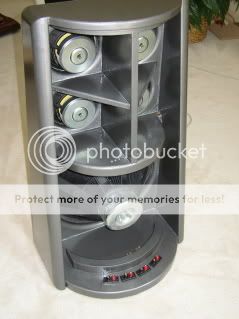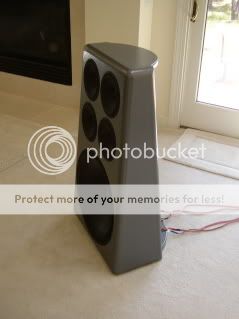I've been playing with some thoughts of a possible open baffle aperiodic bass sollution for small rooms, which would allow for close wall placement. The idea is to totaly encase the back of the driver and baffle with thick "studio" type foam like illustrated below.
Have this been tried before? The driver being the Seas A26RE4 in my case, and the baffle being something like 30x80 cm.
Have this been tried before? The driver being the Seas A26RE4 in my case, and the baffle being something like 30x80 cm.
Attachments
I tried something similar with plenty of polyester stuffing. There was more bass out, though this would be limited to bass drivers only, as people seem to like the reflected mid-high frequencies.
Member
Joined 2003
I've built a few systems like that, except with heavy wool felt (12-25mm thick) sandwiched between heavy steel screens to immobilize the felt. The effect is most prominent at HF where the system tends to act like a monopole, at DC it is still a dipole, with a continuum between the frequency extremes.
The approach seems most useful to achieve a "boxless" sound with reduced midrange reflections from the front wall as well as dipole peaks and dips.
For this baffle, the screens and felt were attached to the semi-circular rails around the back.


The approach seems most useful to achieve a "boxless" sound with reduced midrange reflections from the front wall as well as dipole peaks and dips.
For this baffle, the screens and felt were attached to the semi-circular rails around the back.


Member
Joined 2003
Just an experiment. The 2x2 driver array was "proof of concept" for the 12 driver array used in the Octagon. (multiple small mids with a high breakup frequency rather than one large mid with a low breakup frequency)
Hi kids, let me tell you about a Bozak system I used in 1968 exactly like that. Yes, you just take off the back... the innerds were stuffed full. It had two of those fabulous 8 inch aluminum latex covered cones and a pair of like tweeters.*
Sounds odd, but I think that's one of the best kind of boxes. The best advantages of sealed and open, with no contrived resonances. I never checked out how low it went but I used it with a 140 Hz crossover to my Klipschorn (yes, have the same one today).
I wouldn't be surprised if the OB folks would have liked the sound. And I might add, you could do the EQ they are using. BUT is it wise to go with the Linkwitz OB EQ because it is simple to wire or to go lower acoustically (with a larger box, like here) and more complicated electrically?
*Seemed fabulous at the time. By I also added 9 fried-egg tweeters per side.
Sounds odd, but I think that's one of the best kind of boxes. The best advantages of sealed and open, with no contrived resonances. I never checked out how low it went but I used it with a 140 Hz crossover to my Klipschorn (yes, have the same one today).
I wouldn't be surprised if the OB folks would have liked the sound. And I might add, you could do the EQ they are using. BUT is it wise to go with the Linkwitz OB EQ because it is simple to wire or to go lower acoustically (with a larger box, like here) and more complicated electrically?
*Seemed fabulous at the time. By I also added 9 fried-egg tweeters per side.
Last edited:
Thanks for the replies 🙂 Seems like this could work out well.
How low do you think the Seas A26RE4 would go in a baffle like this? Edge software can't account for driver parameters and foam sollutions such as this.
Do anyone have experience with bass like this vs. sealed? How is does it "feel"? I want punch, tightness and drama... 40 hz is sufficient.
Cheers 🙂
How low do you think the Seas A26RE4 would go in a baffle like this? Edge software can't account for driver parameters and foam sollutions such as this.
Do anyone have experience with bass like this vs. sealed? How is does it "feel"? I want punch, tightness and drama... 40 hz is sufficient.
Cheers 🙂
You can work out the NRC and adjust Linkwitz's spreadsheets accordingly to determine if it'll hit your targets. The baffle size, absorbent material, amount of absorber, and desired distortion and SPL levels are needed to answer your question so you'll probably get better results answering it yourself. Fs of the A2612RE6 is 25Hz, so there's nothing fundamentally stopping getting to 40Hz if you've the necessary equalization capabilities---digital crossover and EQ is handy here.
In my experience dipole bass is good stuff due to the reduced room interactions but the more you damp the rear wave with this approach the more it'll turn into a cardiod. So basically it's a lot of work to end up with something whose directivity is better than a conventional box speaker but worse than an undamped dipole. That's one of of the reasons I abandoned it, though you might find John Kreskovsky's writeups of cardiod/U baffle bass helpful. Another is the amount of foam required; a modest 0.9 NRC in the low bass requires something like four feet of foam. That's both physically and financially unwieldy for most folks and it's probably easier and cheaper to apply room treatments to create live end-dead end or dead end-dead end listening spaces which attenuate the rear wave. See the more recent pages of Stig Erik's Open Baffle with Beyma TLP150 thread in this forum for examples. Personally I've not tried a full on dead end approach but I've fooled with it a bit and concluded that like most directivity things consistency is important. For example, my listening room has two windows behind and a third window and a doorway beside the speakers which I'm not willing to block off, so I can't make the rear hemisphere consistently dead; I've found I get better results from dipole.
As something of an aside, but the logical endpoint of the damped rear wave approach is infinite baffle. As in wall off part of your room and fill the cavity behind the wall with fiberglass, rockwool, and such. The difficulties are cost, labor, space, and getting the wall/baffle holding the speakers not to vibrate. Mostly the latter; unless you're lucky and have just the right closet to start with a nude swinging dipole and room treatment is probably lower cost and easier to build. I couldn't find ways to do infinite baffle or quasi-infinite baffle builds like the one you propose that were competitive with nude swingers.
In my experience dipole bass is good stuff due to the reduced room interactions but the more you damp the rear wave with this approach the more it'll turn into a cardiod. So basically it's a lot of work to end up with something whose directivity is better than a conventional box speaker but worse than an undamped dipole. That's one of of the reasons I abandoned it, though you might find John Kreskovsky's writeups of cardiod/U baffle bass helpful. Another is the amount of foam required; a modest 0.9 NRC in the low bass requires something like four feet of foam. That's both physically and financially unwieldy for most folks and it's probably easier and cheaper to apply room treatments to create live end-dead end or dead end-dead end listening spaces which attenuate the rear wave. See the more recent pages of Stig Erik's Open Baffle with Beyma TLP150 thread in this forum for examples. Personally I've not tried a full on dead end approach but I've fooled with it a bit and concluded that like most directivity things consistency is important. For example, my listening room has two windows behind and a third window and a doorway beside the speakers which I'm not willing to block off, so I can't make the rear hemisphere consistently dead; I've found I get better results from dipole.
As something of an aside, but the logical endpoint of the damped rear wave approach is infinite baffle. As in wall off part of your room and fill the cavity behind the wall with fiberglass, rockwool, and such. The difficulties are cost, labor, space, and getting the wall/baffle holding the speakers not to vibrate. Mostly the latter; unless you're lucky and have just the right closet to start with a nude swinging dipole and room treatment is probably lower cost and easier to build. I couldn't find ways to do infinite baffle or quasi-infinite baffle builds like the one you propose that were competitive with nude swingers.
- Status
- Not open for further replies.
- Home
- Loudspeakers
- Multi-Way
- Dipole/aperiodic hybrid bass sollution
